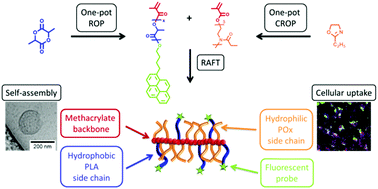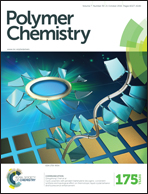Fluorescent amphiphilic heterografted comb polymers comprising biocompatible PLA and PEtOx side chains†
Abstract
A series of amphiphilic heterografted comb polymers comprising various ratios of oligomeric polylactide (PLA) and poly(2-ethyl-2-oxazoline) (PEtOx) side chains was synthesized via the grafting-through method employing the reversible addition–fragmentation chain transfer copolymerization. Two well-defined PLA macromonomers were prepared via ring opening polymerization (ROP) of L-lactide using a calcium-based pre-catalyst, pyrenebutanol as an initiator and methacryloyl chloride as an end-capping agent. The PEtOx macromonomer was obtained from the cationic ROP of EtOx and end-capping with methacrylic acid. The amphiphilic comb polymers self-assembled in aqueous solution to form spherical and worm-like micelles, vesicles and more complex morphologies as a function of the composition, as is evident from dynamic light scattering and cryo-transmission electron microscopy studies. All polymers were found to be non-toxic to L929 cells up to a concentration of 200 μg mL−1. Cellular uptake studies with HEK-293 cells by live cell confocal fluorescence microscopy revealed localization in the cytosol after 4 h and suggest an energy-driven cellular uptake mechanism.


 Please wait while we load your content...
Please wait while we load your content...